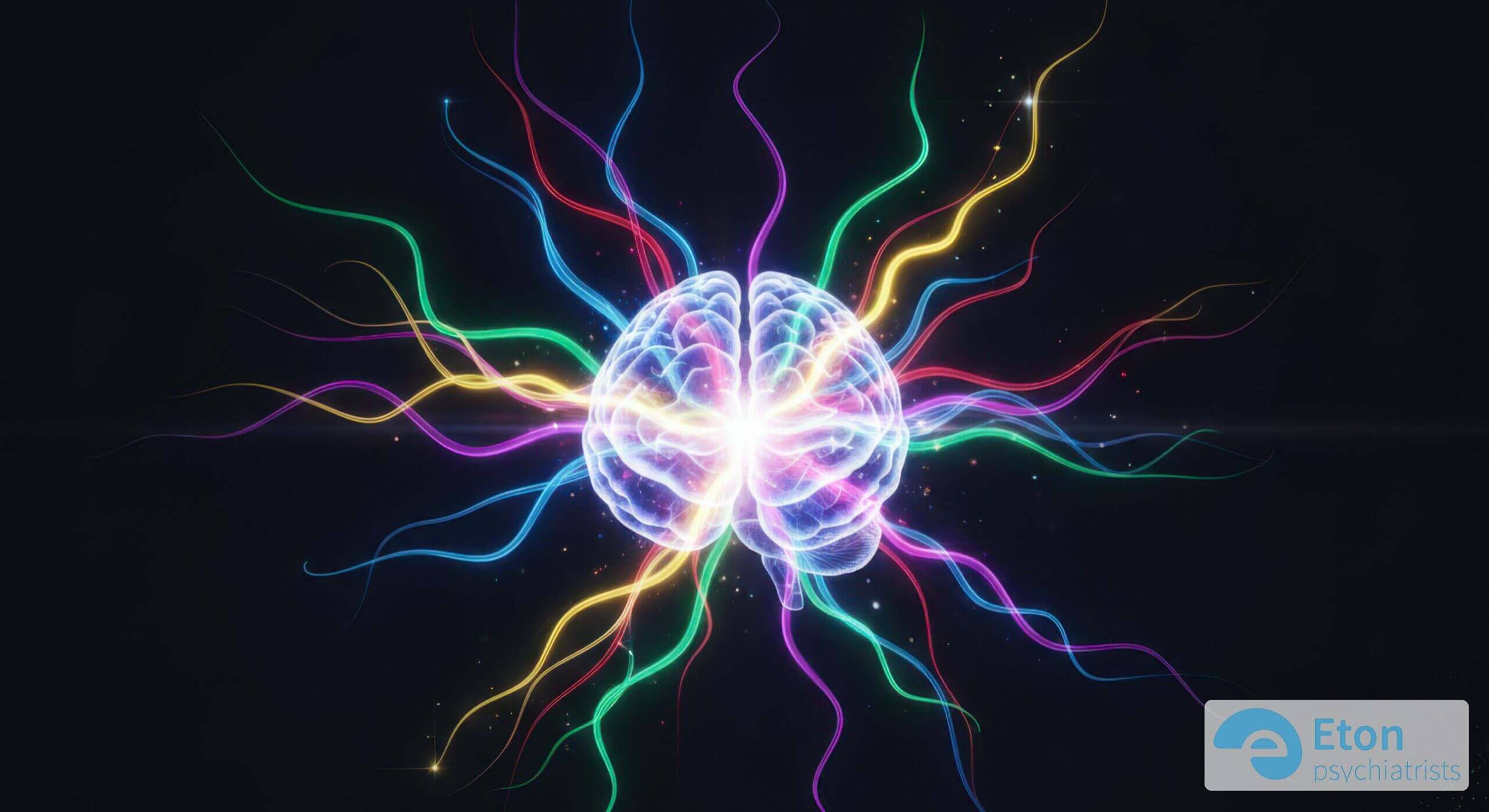
ADHD in Adults: Why Your Brain Feels Different
Listen to the Article
For those on the go or who prefer listening, you can play the full audio version of this deep dive below.

Attention-Deficit/Hyperactivity Disorder (ADHD) is a neurodevelopmental condition that affects the brain’s executive functions, impacting focus, impulse control, and emotional regulation. It is a clinical reality that many adults navigate life with a persistent feeling of being fundamentally out of sync with their peers and their own potential. For a significant number of these individuals, the underlying issue may be undiagnosed and untreated ADHD.
The consequences of this diagnostic gap are profound. Recent reports highlight the scale of the issue, with one estimate from the Nuffield Trust putting the number of adults waiting for an ADHD assessment in England at 117,000. This delay in diagnosis has significant implications, with research linking undiagnosed ADHD in adults to a decreased life expectancy. Understanding the symptoms and the pathways to care is therefore a critical first step. For many, it can be life-changing.
Table of Contents
Key Takeaways
- Prevalence: An estimated 1 in 25 adults in the UK has ADHD, but a large majority are undiagnosed, contributing to a significant public health issue.
- Adult Symptoms: In adults, ADHD often presents less as physical hyperactivity and more as internal restlessness, chronic disorganisation, “time blindness,” and difficulty completing tasks.
- Gender Differences: Women with ADHD are often undiagnosed because their symptoms may be more internalised. They may “mask” their difficulties with behaviours like perfectionism. Hormonal changes can also significantly affect symptom severity.
- Consequences of Being Untreated: Undiagnosed ADHD can lead to secondary mental health issues like anxiety and depression, as well as significant difficulties with careers, finances, and relationships.
- Value of Diagnosis: Receiving a diagnosis in adulthood is a critical turning point. It provides validation and opens the door to effective treatments like medication, therapy, and coaching, which can lead to profound improvements in daily functioning and well-being.
Identifying the Clinical Presentation of Adult ADHD
The classic stereotype of a hyperactive child is often misleading when it comes to the adult presentation of ADHD. In the UK, it is estimated that ADHD affects about 3-4 in every 100 adults. Symptoms in adulthood frequently manifest in more subtle, internalized ways. They are clinically categorized into two primary domains: inattentive and hyperactive/impulsive.

The Inattentive Presentation
This presentation is often characterized by a state of internal disarray, which can be difficult for others to observe, and it is the most common presentation in adults who were not identified in childhood. Symptoms include:
- Difficulty Sustaining Focus: A notable struggle to maintain focus during meetings, extended conversations, or even leisure activities like reading or watching a film.
- Chronic Disorganisation: A persistent difficulty in maintaining an orderly personal and professional environment.
- Time Blindness: An impaired perception of time; a genuine challenge in sensing its passage that results in chronic lateness and difficulty meeting deadlines.
- Everyday Forgetfulness: Misplacing essential items like keys or a wallet, and forgetting appointments or important obligations.
- Task Inertia: A common tendency to begin projects with enthusiasm but struggle to see them through to completion.
The Hyperactive & Impulsive Presentation
In adults, overt hyperactivity often transforms into a pervasive sense of internal restlessness. This can manifest as:
- Internal Restlessness: An inability to relax, with a persistent feeling of being “on the go” or internally agitated that makes periods of stillness uncomfortable.
- Fidgeting: Engaging in small, repetitive physical movements like foot-tapping or pen-clicking.
- Excessive Talkativeness: A tendency to speak at length, often interrupting others or finishing their sentences.
- Impulsive Behaviours: Making hasty decisions without fully weighing the long-term consequences, particularly in areas like finances, career choices, or relationships.
- High Threshold for Stimulation: A propensity for boredom and a seeking of novel or high-intensity experiences.
The Female Experience of ADHD
There is a significant disparity in ADHD diagnosis between genders, with males diagnosed more frequently than females. This is largely attributable to differences in symptom presentation. The diagnostic criteria for ADHD were historically based on research focusing on hyperactive young boys, inadvertently creating a male-centric diagnostic model.

In women, ADHD symptoms may be less overt. They can manifest as appearing “day-dreamy,” being excessively talkative, or developing compensatory strategies like intense perfectionism to mask underlying executive function deficits. This “masking” is a conscious or subconscious effort to conform to neurotypical societal expectations and is both mentally and emotionally exhausting.
Hormonal fluctuations also play a crucial role. Many women report an exacerbation of their ADHD symptoms in relation to their menstrual cycle, and particularly during perimenopause and menopause, when declining oestrogen levels can impact dopamine regulation, worsening difficulties with focus, memory, and emotional control.
The Impact of Untreated ADHD
When left unaddressed, the impact of ADHD can permeate every aspect of an individual’s life. Official NICE guidelines in the UK note that the rate of coexisting psychiatric conditions in adults with ADHD is as high as 75%, most commonly anxiety and depressive disorders. Many also experience Rejection Sensitivity Dysphoria (RSD), an intense emotional response to perceived rejection or criticism.

Furthermore, trouble with things like planning, staying organized, or focusing can lead to professional and financial challenges, including underachievement in the workplace, frequent job changes, and financial instability stemming from issues like impulse spending and poor financial management. Finally, the condition can cause interpersonal difficulties, as symptoms such as inattentiveness and emotional dysregulation can be misinterpreted by others, placing significant strain on relationships with partners, family, and friends.
A formal diagnosis is the crucial first step toward managing these challenges. It provides access to evidence-based interventions, including medication, specialised psychotherapy (such as CBT for ADHD), and ADHD coaching, all of which can empower individuals to develop effective strategies and improve their quality of life.
Why Trust Eton Psychiatrists?
Choosing a clinic for a life-changing assessment requires immense trust. On our About Us page, you can learn more about how we have built our practice on a foundation of deep clinical expertise in the overlapping fields of ADHD and Autism. We are not a general practice; we are a specialist psychiatry clinic dedicated to understanding and diagnosing complex neurodevelopmental conditions in adults.
Our team of Consultant Psychiatrists understands that no two individuals are the same. We reject a one-size-fits-all approach, especially when dealing with the intricate challenges faced by our Deaf and hard-of-hearing clients. Our process is rooted in empathy, clinical rigour, and a commitment to providing the validation and clarity that can unlock a new chapter in your life. We are committed to culturally sensitive care, ensuring communication is clear and respectful throughout your journey with us.
Summary
- Prevalence: An estimated 1 in 25 adults in the UK has ADHD, but a large majority are undiagnosed, contributing to a significant public health issue.
- Adult Symptoms: In adults, ADHD often presents less as physical hyperactivity and more as internal restlessness, chronic disorganisation, “time blindness,” and difficulty completing tasks.
- Gender Differences: Women with ADHD are often undiagnosed because their symptoms may be more internalised. They may “mask” their difficulties with behaviours like perfectionism. Hormonal changes can also significantly affect symptom severity.
- Consequences of Being Untreated: Undiagnosed ADHD can lead to secondary mental health issues like anxiety and depression, as well as significant difficulties with careers, finances, and relationships.
- Value of Diagnosis: Receiving a diagnosis in adulthood is a critical turning point. It provides validation and opens the door to effective treatments like medication, therapy, and coaching, which can lead to profound improvements in daily functioning and well-being.
Sources
- Royal College of Psychiatrists, “ADHD in Adults”, Accessed September 2025.
- BBC News, “More than 172,000 people waiting for autism assessment in England”, July 2024.
- Barkley, R. A., “Hyperactive Child Syndrome and Estimated Life Expectancy at Young Adult Follow-Up”, Journal of Attention Disorders, October 2018.
- National Institute for Health and Care Excellence (NICE), “Attention deficit hyperactivity disorder: diagnosis and management [NG87]”, March 2018.
Frequently Asked Questions
How long is the NHS waiting list for an ADHD assessment?
Waiting lists in England can be extremely long. While official data varies, reports in 2024 have highlighted estimates of over 100,000 adults waiting for an assessment. The wait time varies significantly by region but can often be several years.
What are the first signs of ADHD in adult women?
The initial signs in women are often internalized. They include chronic feelings of being overwhelmed, severe disorganization that is masked by perfectionism, “zoning out” during conversations, extreme emotional sensitivity (Rejection Sensitivity Dysphoria), and a sense of not living up to one’s potential despite being intelligent.
Can I use 'Right to Choose' for my ADHD diagnosis?
Yes, in England, the NHS ‘Right to Choose’ policy allows you to select a qualified private clinic that has a contract with the NHS to provide your assessment, funded by the NHS. This can significantly reduce the waiting time compared to staying within your local NHS trust.
What happens if ADHD is left untreated?
Untreated ADHD can have serious consequences. It is strongly linked to secondary mental health conditions like anxiety and depression, career instability, financial difficulties, relationship strain, and substance use issues. Research also shows a correlation with reduced life expectancy.



